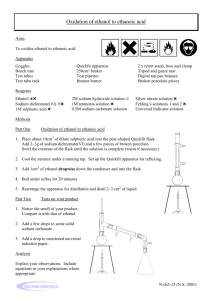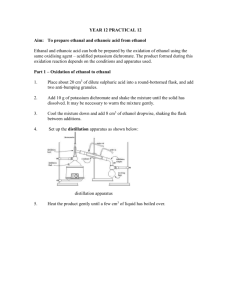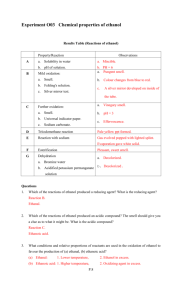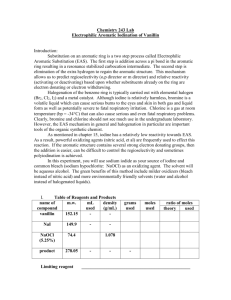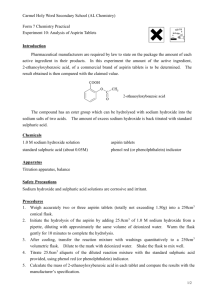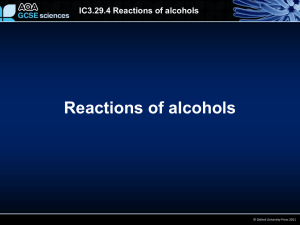Organic Chemistry | Experiments
advertisement
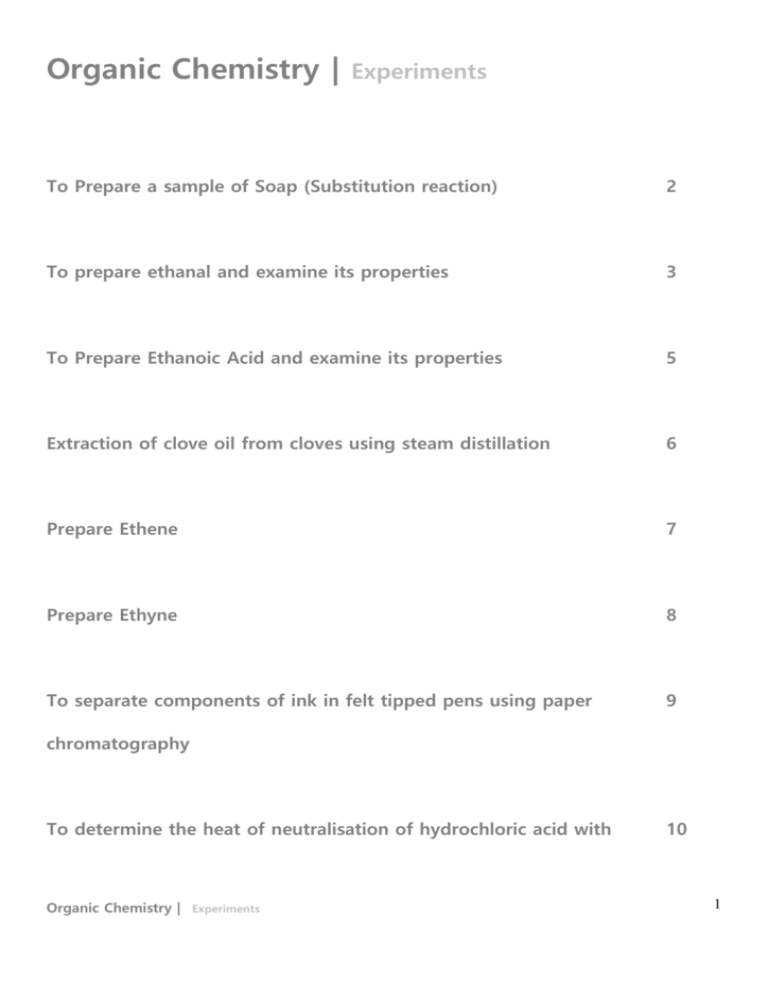
Organic Chemistry | Experiments To Prepare a sample of Soap (Substitution reaction) 2 To prepare ethanal and examine its properties 3 To Prepare Ethanoic Acid and examine its properties 5 Extraction of clove oil from cloves using steam distillation 6 Prepare Ethene 7 Prepare Ethyne 8 To separate components of ink in felt tipped pens using paper 9 chromatography To determine the heat of neutralisation of hydrochloric acid with Organic Chemistry | Experiments 10 1 sodium hydroxide. 2 To Prepare a sample of Soap (Substitution reaction) • Soap consists of the salts of long chain carboxylic acids e.g. sodium stearate. These long chain carboxylic acids are made from fats or oils via saponification. • For example the naturally occuring glyceryl tristearate may be hydrolysed to form sodium stearate and glycerol • Glycerol is a useful by-product used to manufacture explosive nitroglycerine • Potassium and sodium hydroxide are used to manufacture soaps, potassium soaps tend to be milder. • The non polar part of the soap i.e. the long chain of carbon atoms dissolves non polar substances like oil and grease from our skin. • The polar part dissolves polar substances such as the salt from our sweat. • To prepare soap you need to begin with a substance containing naturally occuring ester, e.g. Palm Oil, Olive Oil, Coconut Oil. 1. Place 6cm^3 sunflower in a 100 cm^3 QuickFit flask. Add 3g sodium hydroxide and 30cm^3 ethanol to the flask. Ethanol acts as a solvent for the oil or lard. Note that the sodium hydroxide forms the sodium salt of the carboxylic acid rather than the acid itself. this is a hydrolysis reaction. 2. Add several anti bumping granules to the flask, set up the reflux apparatus. Refluxing is a laboratory technique in which a liquid is boiled in a container that is attached to a vertical condenser. Vapour from the boiling liquid condenses and flows back into the flask. Thus the liquid is kept at its boiling point without the loss of vapour. This prevents the flask boiling dry and allows sufficient time for the reaction to occur. Organic Chemistry | Experiments 3 3. Heat the mixture/ boil it gently for 30 minutes over a water bath, at this point, saponification should be complete. During the reflux the walls of the flask may become coated with the sodium salts of the long chain acids or with oil that has not yet been hydrolysed. Gently swirl flask to wash these materials from the walls back into the reaction mixture. 4. Allow to cool and rearrange for distillation. Distilling off the most of the ethanol solvent makes it easier to isolate the soap. Stop once you have collected about 20cmˆ3 of it 5. Allow apparatus to cool for a few minutes then pour the hot reaction mixture into a concentrated solution of brine. brine is a solution of salt in water. Soap doesn’t dissolve in brine and will precipitate however, excess NaOH will dissolve in it. 6. Filter off the soap using a filter funnel and wash with some fresh salt solution to remove any excess sodium hydroxide. Use a spatula add some to a test tube and shake with some deionised water. - froth. 4 To prepare ethanal and examine its properties • Here we oxidize ethanol to make ethanal. Sodium dichromate is the oxidizing agent Na2Cr207. Chromium changes from Cr+6 (orange) to Cr+3 (green). • Use excess alcohol rather than excess oxidizing agent and distill off ethanal as it is formed means that the ethanal will not further oxidize into Ethanoic acid. • We use H2SO4 or sulfuric acid to supply the H+ ions needed for the reaction to occur. • C2H50H + Na2Cr2O7 = CH3CHO • Weigh out 5g sodium dichromate crystals and dissolve using a glass rod in a beaker of 5 cm^3 water. Add 4cmˆ3 of ethanol to this. • Pour 6 cm^3 of water into a pear shaped flask of capacity 50cm^3. Pear shaped flasks are useful for small quantities of liquids, if a round bottom was used the liquid would be spread over a larger surface area and this may cause decomposition and charring. • Slowly add 2 cm^3 concentrated sulfuric acid. The reaction is highly exothermic, as the acid sinks down it generates heat, therefore GENTLY swirl the flask and run under cold water. If water were added to/ the acid it would float on the surface of the acid and the heat generated would cause a dangerous and hot acid spray. Add anti bumping chips. • Set up with Liebeg condenser attached to a conical flask to collect the ethanal. Note that the ethanal’s boiling point is 27 degrees celsius so surround that conical flask in a bath of ice cold water. Organic Chemistry | Experiments 5 • Use a beaker of boiling water to carefully heat the acid to 70 degrees. Remove once it has reached the temperature - the reaction is very exothermic and could become quite violent • Add the mixture of alcohol and dichromate slowly from the dropping funnel so that the liquid in the pear flask is maintained at boiling point. The reaction is exothermic and further heating shouldnt be necessary once started, re heat if it appears to stop. • Continue until about 10cm^3 of the distillate has been collected. It is clear liquid with impurities like ethanol, water and ethanoic acid. Water can be removed via anhydrous sodium sulfate and the sodium sulfate is then filtered off to give dry ethanal. Test: Potassium Permangenate • Acidify 1/10 of a test tube of dilute potassium permangenate with the same quantity of dilute sulfuric acid. • Add 5 drops of ethanal to it and stand in a beaker of hot water for a few minutes - pale pink to colourless Fehling’s Solution • Fehling’s A is copper sulfate in water, Fehling’s B is potassium sodium tartrate. Add 1/10 of Fehling’s A to the same quantity of Fehling’s B. • Add 5 drops of ethanal and stand in a beaker of hot water for a few minutes • Cu2+ goes to Cu+, the solution goes from Blue to Brick red , this is a precipitate of Copper Oxide Cu2O. 6 • Aldehydes are good reducing reagents, they themselves are oxidised so the ethanal changes to ethanoic acid. Ketones however, are difficult to oxidise and no colour change is observed. Ammoniacal Silver Nitrate or Silver Mirror test. • To 1 cm^3 of silver nitrate solution add 1 drop of sodium hydroxide. This forms a brown precipitate of silver oxide. • Add drop by drop, dilute ammonia solution until the brown precipitate has disappeared. This is called tollen’s reagent and must always be freshly prepared because if stored for long, explosive products may form. • Wash out another test tube with detergent, rinse with ordinary water and then with acetone. Allow to dry and pour the Tollen’s reagent in. Add 3 drops of ethanal and stand in boiling water for a few minutes. • A silver mirror is deposited on the inside of the test tube. • Silver oxide dissolves in ammoniacal solution to form ammoniacal silver nitrate - Ag+ is reduced to Ag and precipitates out as a silver mirror, ethanal is the reducing reagent and it itself is oxidized to ethanoic acid. Note that it is only possible to oxidize Ketones if VERY strong agents like hot concentrated nitric acid are used as they break oxidizing up the molecule into at least 2 molecules of carboxylic acid. Organic Chemistry | Experiments 7 To Prepare Ethanoic Acid and examine its properties • Ethanol is oxidized to ethanoic acid using a mixture of sodium dichromate and dilute sulfuric acid. Here, the dichromate is in excess (oxidizing agent) and by refluxing the mixture we ensure further oxidation of ethanol to ethanoic acid occurs rather than distilling off the volatile ethanal before further oxidation. • Use a graduated dropper to measure out 3.5 cm^3 concentrated sulfuric acid to 6cm^3 deionized water in a pear shaped flask. Coll under the tap and gently stir. • Add 5g sodium dichromate to this and a few anti bumping granules. • Place 1.5 cm^3 ethanol into 5 cm^3 water in the dropping funnel. Immerse the pear flask in a beaker of cool water. Add drop by drop and wait for the reaction to subside before adding another drop. The cool water helps to control the temperature and the reaction from becoming too vigorous, the cold condenser also helps cool the mixture of alcohol and water and control the exothermic reaction between the alcohol and the acidified dichromate. If it were placed directly into the flask the reaction would be too vigorous and the contents would spurt out. • Having added all the mixture, bring the beaker water to boil and reflux the contents for about 20 minutes. Notice the orange/green colour change. • Remove the hot water bath, allow to cool and set up to distill off the ethanoic acid. Use a bunsen burner and wire gauze as the boiling point of ethanoic acid is 118 degrees. • Continues until 5 cm^3 aqueous ethanoic acid is attained. It is unlikely to have many impurities due to the sever conditions but ethyl ethanoate, ethanol and water are possible. Examine Properties of ethanoic acid: 8 • Ethanoic acid reacts with sodium hydroxide to form the salt sodium ethanoate and water. (phenolphthalein turns from pink to colourless) • Ethanoic acid reacts with sodium carbonate to liberate carbon dioxide, for sodium ethanoate and water. (extinguishes a lighted taper) • Ethanoic acid reacts with magnesium metal to liberate hydrogen gas and the salt magnesium ethanoate. (hydrogen lights with a pop) Extraction of clove oil from cloves using steam distillation • Eugenol is the oil found in cloves. Flavours food products such as spiced beef, sweets, sausages, sauces, pickles... • Antiseptic properties also is used for pharmaceutical preparations, perfumes, soaps etc... • The steam trap collects any steam that has condensed into water and prevents the falsk with the cloves quickly filling with water from condensed steam. • Place 1.5 litres of boiling water into the steam generator and insert the safety tube and rubber stopper. • Place about 5g cloves into the flask with 10cm^3 water. • Turn on hotplate and pass steam through the flask for about 40 minutes until the clove oil emulsion is carried over suring the distillation. It has a milky colour. Organic Chemistry | Experiments 9 We do not extract the eugenol (solvent extraction) from the emulsion as the process is time consuming, however it can be done using organic solvents like petroleum ether or dichloromethane. 10 Prepare Ethene • This is done by dehydrating an alcohol. • Pour some ethanol into a boiling tube add some glass wool to soak it up and use a glass rod to push it down the boiling tube to hold the ethanol in place while the reaction occurs. • Place some Aluminium oxide in the neck of the tube/ half way along the already horizontally clamped tube. • Heat with the blue flame of a bunsen burner. As the aluminium oxide becomes hot the heat reaches the ethanol and the ethanol changes into a vapour as it passes over the aluminium oxide and is dehydrated to form ethene. • Collect 5 test tubes of the gas, once they have been filled loosen the boss head of the retort stand and raise the apparatus up so that the delivery tube is no longer dipping into the water. THEN turn off the bunsen burner. If the tube were left, a suck back of water would occur as the tube cools as soon as the heat is off and the cold water causes the tube to crack. • Colourless gas, sweetish smell and insoluble in water but does dissolve in organic solvents like cyclohexane or chloroform. • A lighted wax taper burns with a luminous flame, limewater turns milky - produces CO2 when burned. • Decolourises bromine water - yellow red to colourless • Decolourises acidified KMnO4 - purple to colourless Organic Chemistry | Experiments 11 12 Prepare Ethyne • Reaction of calcium dicarbide with water, ethyne obtained by bubbling it through acidified copper sulfate solution. • Calcium carbide cannot be obtained in a pure state and contains Calcium Sulfide, Calcium phosphide and calcium nitride. Therefore the ethyne obtained will be contaminated with Phophine, Hydrogen sulfide and ammonia. By bubbling it through Cu2SO4 solution, it removes these impurities. • Ethyne gas forms explosive mixture with air so do not bring naked flame nearby. • Use a small amount of calcium carbide and don’t touch as moisture from hands may start the reaction. • Add water slowly to maintain an even evolution of ethyne. • Colourless gas with a sweetish smell if there are no impurities. It is insoluble in water but soluble in organic solvents. • Burns with a luminous smokey flame and a great deal of soot or unburnt carbon is formed • Decolourises bromine water - yellowish/red to colourless • Decolourises dilute acidified KMnO4 - purple to colourless Organic Chemistry | Experiments 13 To separate components of ink in felt tipped pens using paper chromatography • Cut a suitable length of chromatography paper to fit the gas jar, avoid handling as oil from hands could affect results. • Draw a faint pencil line 2cm from bottom and place a small dot of each of the 2 or 3 different coloured inks on the line, make sure they are well spaced and write in pencil, the colour of the ink near the dot. • Place water into the gas jar to fill it about 1cm high and then place in the length of the chromatography paper supported by a pencil and paper clip, allow time for the solvent to rise through the paper until a good separation of colours is observed. If the ink is “water insoluble” use an organic solvent. 14 To determine the heat of neutralisation of hydrochloric acid with sodium hydroxide. Organic Chemistry | Experiments 15 • Using a graduated cylinder place 50cm^3 of 1M hydrochloric acid into one polystyrene cup (doesn’t absorb heat) and place 50cm^3 of 1M sodium hydroxide into another polystyrene cup. • Measure the temperatur of the HCL solution • Wash and dry the thermometer and measure the temperature of the NaOH solution. • When both are at the same temperature quickly add the BASE TO THE ACID and stir well using a plastic coated stiff wire, avoid loss of liquid by splashing. • Place a lid on the cup and with continuous stirring measure the maximum temperature reached. • Temperature of HCL before mixing • Temperature of NaOH before mixing • Highest temperature reached after mixing • Temperature rise • Number of moles of acid used • number of moles of base used • mass of solution • Heat liberated = M X C X (t2-t1) • C = specific heat capacity, M = mass kG and T1/T2 = temperature difference • The specific heat capacity is the amount of heat required to raise the temperature of 1Kg of a substance by 1K • number of moles neutralised = (volume X molarity) divided by 1000, find how much 1 Mole neutralizes and determine whether it is exothermic or endothermic, i.e. exo = - kJmol^-1 and endo= + kJmol^-1 16
